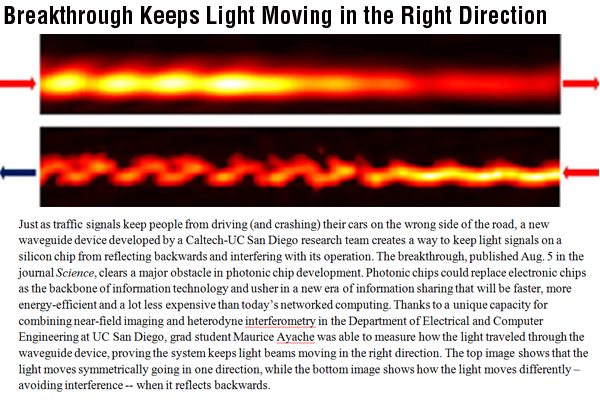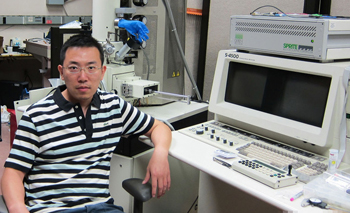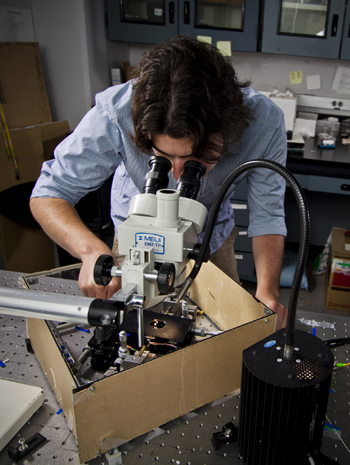Breakthrough in Photonic Chip Research Paves Way for Ultrafast Information Sharing
San Diego, Calif., Aug. 4, 2011 — Researchers at the California Institute of Technology and the University of California, San Diego have discovered a way to prevent light signals on a silicon chip from reflecting backwards and interfering with its operation. Otherwise, the light beams would interfere with lasers and other photonic components on the chip and make the chip unstable.
|
The breakthrough marks a significant achievement in the development of integrated photonic chips that could replace electronic chips as the backbone of information technology. Their findings are published Aug. 5 in the journal Science.
Although information systems now rely primarily on fiber optic networks to connect and share data around the world using photons instead of electrons, the underlying computer technology is still based on electronic chips, which are slower and more prone to data loss than photonic chips. Lab versions of photonic chips being developed across the industry are already supporting data transfer rates of 10 gigabits per second, and in just five years, photonic chips could achieve data transfer rates of over 40 Gbps – an order of magnitude higher than the speed of today’s networks. The shift towards optical networks will make information sharing faster, more energy-efficient and less costly.
Electronic chips rely on a diode to isolate electrical signals, enabling current to travel in just one direction and prevent interference. Lead researcher Liang Feng, a postdoctoral fellow at Caltech who earned his doctorate in electrical engineering from the UC San Diego Jacobs School of Engineering in 2010, said engineers have been trying to duplicate the diode system on photonic chips for 20 years.
The Caltech-UC San Diego research team developed a metallic-silicon optical waveguide system to channel light so it travels in different patterns depending on its propagation direction. The pattern is symmetric when traveling forward and asymmetric when reflected backwards along the same path. Similar to the diode in electronics, the backscattered light is dissipated as a result.
“This discovery will help to realize a long-term goal of combining electronics with photonics to enable scalable, energy-efficient and cost-effective technology that will have a tremendous impact on such information systems as supercomputers, the Internet, and data centers,” said Yeshaiahu (Shaya) Fainman, professor and chair of the UC San Diego Department of Electrical and Computer Engineering. “Computer technology will be able to handle a lot more data, faster and at lower cost, which will benefit large-scale business and government users as well as gadget-loving consumers.”
|
“Although that particular project was not successful, I never gave up trying to make it work,” said Feng.
He credits the multidisciplinary training he received under Fainman at UCSD – including optics, electromagnetics and physics – for building his knowledge in design, fabrication and measurement that made his discovery possible. So it was inevitable that Feng turned to his former professor, Fainman, and UCSD graduate student Maurice Ayache to conduct the measurement and analysis for the experiment that ultimately proved Feng’s idea works.
The Caltech-UCSD research team is part of the National Science Foundation’s Engineering Research Center for Integrated Access Networks (CIAN) that was created across several institutions – including UCSD’s California Institute for Telecommunications and Information Technology (Calit2) – to develop an all-optical backbone for the next-generation of data centers where messages, images and other chunks of data are aggregated, stored and moved around the world’s computer networks. Funding for this project was provided by the National Science Foundation Engineering Research Centers program and the Defense Advanced Research Projects Agency.
Fainman, who is also deputy director of CIAN, said this research project offers a great example of the interactive and collaborative culture developing among the universities involved in the effort. In this project, Feng and his colleagues at Caltech designed and fabricated the waveguide device while Ayache figured out how to measure the variation of the light beam inside.
The Proof is in the Measurement
|
“It’s like water in an insulated water pipe,” Ayache said. “You can’t see or hear the water inside, but if you held a stethoscope to the pipe you could hear the current moving and know what’s happening. The integration of NSOM and the interferometer was key to being able to prove that what we thought was going on inside the waveguide was actually going on.”
Ayache said Fainman’s team at UCSD is one of a few groups in the world that have the capability and capacity to combine near-field imaging and heterodyne interferometry to achieve this kind of measurement and analysis of light signals.
The other authors on the paper are Jingquing Huang, a Caltech graduate student; Axel Scherer, professor of electrical engineering, applied physics and physics, and co-director of the Kavli Nanoscience Institute at Caltech; and Ye-Long Xu, Ming-Hiu Lu, and Yan-Feng Chen of the Nanjing National Laboratory of Microstructures in China.
Media Contacts
Catherine Hockmuth, chockmuth@ucsd.edu, 858-822-1359



